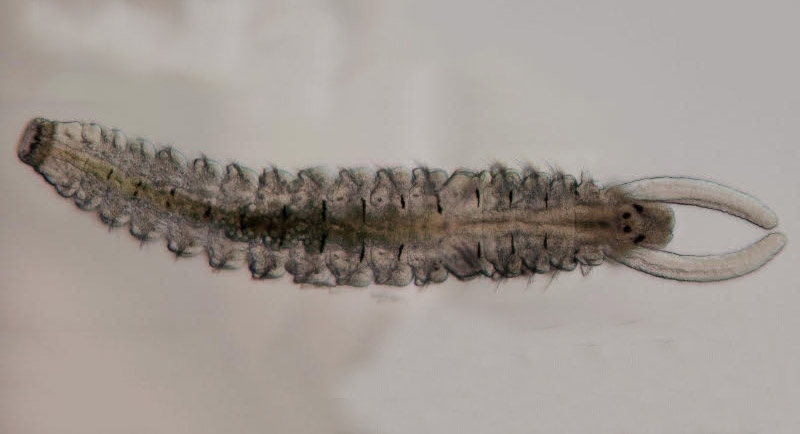

Researchers have identified shell borers of the class Polychaeta on the northern coast of São Paulo State (image: Polydora hoplura / Álvaro Migotto)
Researchers have identified shell borers of the class Polychaeta on the northern coast of São Paulo State.
Researchers have identified shell borers of the class Polychaeta on the northern coast of São Paulo State.

Researchers have identified shell borers of the class Polychaeta on the northern coast of São Paulo State (image: Polydora hoplura / Álvaro Migotto)
By Peter Moon | Agência FAPESP – Oyster, scallop and mussel farming in Brazil is at risk of infestation by Polydora hoplura, an annelid polychaete, or a bristle worm in the class of marine worms referred to as Polychaeta.
The warning comes from biologists Álvaro Migotto, affiliated with the University of São Paulo’s Marine Biology Center (CEBIMAR-USP), and Vasily I. Radashevsky, a world expert on polychaetes affiliated with the A.V. Zhirmunsky Institute of Marine Biology in Vladivostok, Russia.
Migotto and Radashevsky identified the presence of P. hoplura, an invasive species that originated in the Pacific Ocean, in wild oysters collected in Ilhabela, on the northern coast of São Paulo State. This is the first time that the worm has been found in the South Atlantic. The study was published in the journal Marine Biodiversity. Radashevsky came to Brazil thanks to an International Visiting Researcher Grant from FAPESP.
P. hoplura’s presence in Brazil is a potential threat to oyster farming in Santa Catarina State. According to data from the Brazilian Geography & Statistics Institute (IBGE), Santa Catarina produced 21,650 metric tons of oysters in 2014, or 98% of the national total. Migotto said researchers at the Federal University of Santa Catarina (UFSC) have confirmed the presence of bristle worms in local oyster farms but so far have been unable to specify the species or the possible negative impact on this activity.
How did P. hoplura reach the Brazilian coast? Precisely how does its presence threaten oyster farming in Santa Catarina? P. hoplura is only one of dozens of species in the genus Polydora. They are shell borers that burrow into the calcareous substructure of mollusk shells in order to settle and live there.
The presence of P. hoplura creates an imbalance in the bivalve’s development and health. This can happen in various ways. If the contaminated mollusk has a very thin shell, the worm can penetrate as far as its host’s soft interior. In this case, the mollusk will expend more energy producing calcareous material to cover and insulate the tiny burrow made by the worm. This energy has to be diverted from vital functions such as feeding and reproduction.
In a generalized infestation, dozens of P. hoplura individuals may bore holes into a single oyster. As a result, the oyster uses up all its energy trying to protect itself from the invaders and eventually dies.
In countries with infestations of Polydora and other polychaetes, oyster farming is badly affected. There are specific cases in New Zealand and South Africa, where output has been drastically reduced. “Highly infested oysters use up a lot of energy in shell production. If the infestation is excessive, they die,” Migotto said. “In some cases, aquaculture has collapsed completely because of these infestations.”
How has this invasive species spread around the world? According to Migotto, it probably came to Brazil in seeds of Crassostrea gigas, the Pacific cupper oyster, a species native to Japan but farmed worldwide.
Breeders import seed oysters when starting a farm and on a regular basis thereafter in order to maintain genetic diversity and the health of brood stocks. In the Americas, invasive polychaete species have been found in the waters of California and Maine, on the US West and East Coasts, respectively, and also on the coast of Chile.
“We’ve found P. hoplura on the São Paulo coast in shells and native mollusks. If they came in seeds of C. gigas, we can assume the invasive species has spread all the way down to the coast of Brazil’s South region,” Migotto said.
There are several other species of Polydora in the South Atlantic. They are also shell borers but are not reported to have had a significant effect on aquaculture.
The article by Vasily I. Radashevsky and Alvaro E. Migotto, “First report of the polychaete Polydora hoplura (Annelida: Spionidae) from North and South America and Asian Pacific,” published in the journal Marine Biodiversity, can be retrieved at link.springer.com/article/10.1007/s12526-016-0515-0.
Republish
The Agency FAPESP licenses news via Creative Commons (CC-BY-NC-ND) so that they can be republished free of charge and in a simple way by other digital or printed vehicles. Agência FAPESP must be credited as the source of the content being republished and the name of the reporter (if any) must be attributed. Using the HMTL button below allows compliance with these rules, detailed in Digital Republishing Policy FAPESP.




